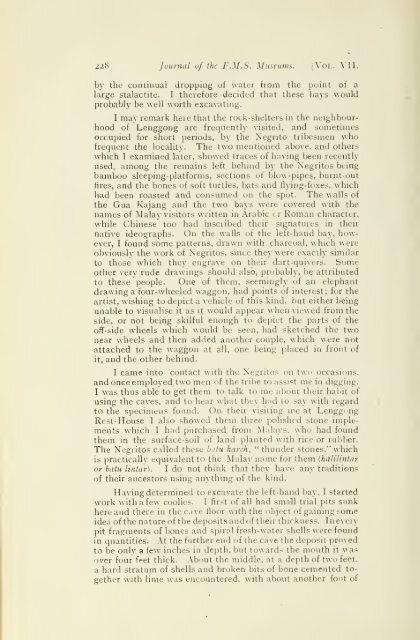Journal of the Federated Malay States museums - Sabrizain.org
Journal of the Federated Malay States museums - Sabrizain.org
Journal of the Federated Malay States museums - Sabrizain.org
Create successful ePaper yourself
Turn your PDF publications into a flip-book with our unique Google optimized e-Paper software.
228 <strong>Journal</strong> <strong>of</strong> <strong>the</strong> F.M.S. Museums. |Vol. Vll,<br />
by <strong>the</strong> continual dropping <strong>of</strong> water from <strong>the</strong> point <strong>of</strong> a<br />
large stalactite. I <strong>the</strong>refore decided that <strong>the</strong>se bays would<br />
probably be well worth excavating.<br />
I may remark here that <strong>the</strong> rock-shelters in <strong>the</strong> neighbourhood<br />
<strong>of</strong> Lenggong are frequently visited, and sometimes<br />
occupied for short periods, by <strong>the</strong> Negrito tribesmen who<br />
frequent <strong>the</strong> locality. The two mentioned above, and o<strong>the</strong>rs<br />
which I examined later, showed traces <strong>of</strong> having been recently<br />
used, among <strong>the</strong> remains left behind by <strong>the</strong> Negritos being<br />
bamboo sleeping-platforms, sections <strong>of</strong> blow -pipes, burnt-out<br />
fires, and <strong>the</strong> bones <strong>of</strong> s<strong>of</strong>t turtles, bats and flying-foxes, which<br />
had been roasted and consumed on <strong>the</strong> spot. The walls <strong>of</strong><br />
<strong>the</strong> Gua Kajang and <strong>the</strong> two bays were covered with <strong>the</strong><br />
names <strong>of</strong> <strong>Malay</strong> visitors written in Arabic cr Roman character,<br />
while Chinese too had inscribed <strong>the</strong>ir signatures in <strong>the</strong>ir<br />
native ideographs. On <strong>the</strong> walls <strong>of</strong> <strong>the</strong> left-hand bay, however,<br />
I found some patterns, drawn with charcoal, which were<br />
obviously <strong>the</strong> work <strong>of</strong> Negritos, since <strong>the</strong>y were exactly similar<br />
to those which <strong>the</strong>y engrave on <strong>the</strong>ir dart-quivers. Some<br />
o<strong>the</strong>r very rude drawings should also, probably, be attributed<br />
to <strong>the</strong>se people. One <strong>of</strong> <strong>the</strong>m, seemingly <strong>of</strong> an elephant<br />
drawing a four-wheeled waggon, had points <strong>of</strong> interest; for <strong>the</strong><br />
artist, wishing to depict a vehicle <strong>of</strong> this kind, but ei<strong>the</strong>r being<br />
unable to visualise it as it would appear when viewed from <strong>the</strong><br />
side, or not being skilful enough to depict <strong>the</strong> parts <strong>of</strong> <strong>the</strong><br />
<strong>of</strong>f-side wheels which would be seen, had sketched <strong>the</strong> two<br />
near wheels and <strong>the</strong>n added ano<strong>the</strong>r couple, which were not<br />
attached to <strong>the</strong> waggon at all, one being placed in front <strong>of</strong><br />
it, and <strong>the</strong> o<strong>the</strong>r behind.<br />
I came into contact with <strong>the</strong> Negritos on two occasions.<br />
and once employed two men <strong>of</strong> <strong>the</strong> tribe to assist me in digging.<br />
I was thus able to get <strong>the</strong>m to talk to me about <strong>the</strong>ir habit <strong>of</strong><br />
using <strong>the</strong> caves, and to hear what <strong>the</strong>y had to say with regard<br />
to <strong>the</strong> specimens found. On <strong>the</strong>ir visiting me at Lenggong<br />
Rest-House I also showed <strong>the</strong>m three polished stone implements<br />
which I had purchased from <strong>Malay</strong>s, who had found<br />
<strong>the</strong>m in <strong>the</strong> surface-soil <strong>of</strong> land planted with rice or rubber.<br />
The Negritos called <strong>the</strong>se b.du kareh, " thunder stones," which<br />
is practically equivalent to <strong>the</strong> <strong>Malay</strong> name for <strong>the</strong>m {haliliniar<br />
or batu lintar). I do not think that <strong>the</strong>y have any traditions<br />
<strong>of</strong> <strong>the</strong>ir ancestors using anything <strong>of</strong> <strong>the</strong> kind.<br />
Having determined to excavate <strong>the</strong> left-hand bay, I started<br />
work withafew coolies. I first <strong>of</strong> all had small trial pits sunk<br />
here and <strong>the</strong>re in <strong>the</strong> cave floor with <strong>the</strong> object <strong>of</strong> gaining some<br />
idea <strong>of</strong> <strong>the</strong> nature <strong>of</strong> <strong>the</strong> deposits and <strong>of</strong> <strong>the</strong>ir thickness. I n every<br />
pit fragments <strong>of</strong> bones and spiral fresh-water shells were found<br />
in quantities. At <strong>the</strong> fur<strong>the</strong>r end <strong>of</strong> <strong>the</strong> cave <strong>the</strong> deposit proved<br />
to be only a few inches in depth, but towards <strong>the</strong> mouth it was<br />
over four fret thick. About <strong>the</strong> middle, at a depth <strong>of</strong> two feet,<br />
a hard stratum <strong>of</strong> shells and broken bits <strong>of</strong> bone cemented toge<strong>the</strong>r<br />
with lime was encountered, with about ano<strong>the</strong>r foot <strong>of</strong>
















